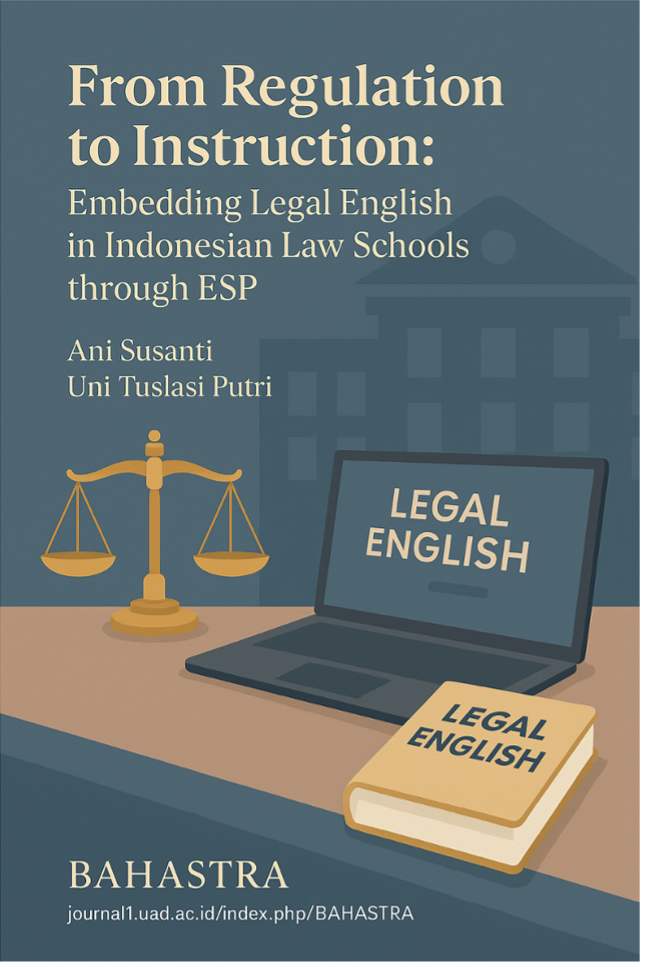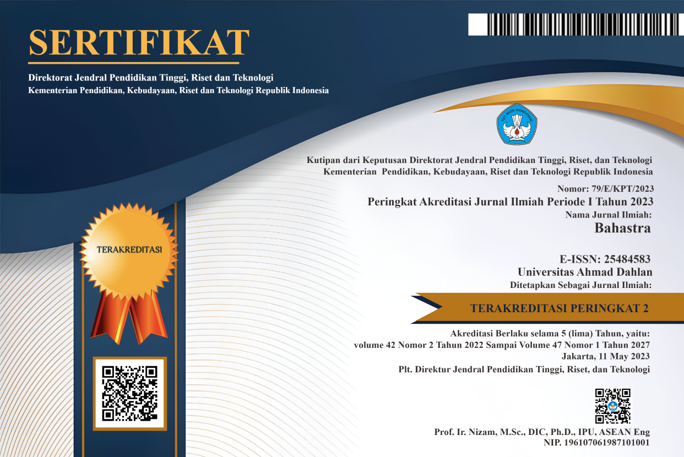From regulation to instruction: Embedding legal English in Indonesian law schools through ESP
DOI:
https://doi.org/10.26555/bs.v45i2.1659Keywords:
English for Specific Purposes Globalization, Language Pedagogy , Legal Education , Legal EnglishAbstract
This study investigates the integration of Legal English into Indonesian law schools, emphasizing the persistent gap between national language policy and pedagogical implementation. Although Indonesian regulations, such as Law No. 24 of 2009 and Law and Human Rights Ministerial Regulation No. 13 of 2018, recognize the use of English in legal communication, its curricular application remains fragmented and discretionary. Adopting an interdisciplinary mixed approach that combines doctrinal legal analysis, English for Specific Purposes (ESP) literature review, and questionnaire-based inquiry involving law students and lecturers, this study examines how policy mandates are interpreted in classroom practice. Findings reveal a clear policy–practice misalignment: Legal English is often treated as an elective subject, lecturers lack institutional support and ESP training, and students report limited opportunities for structured instruction despite acknowledging its importance for professional competence. The paper uniquely bridges regulatory and pedagogical perspectives by demonstrating how doctrinal frameworks can inform curriculum reform through Content-Based Instruction (CBI), Task-Based Learning (TBL), and mediation-oriented pedagogy. By aligning regulatory obligations with evidence-based ESP principles, the study proposes practical strategies for curriculum design, faculty development, and institutional policy to strengthen Legal English as a core component of legal education in Indonesia.References
Albesher, K. B. (2023). Inclusion of English for specific purposes in high school tracks: A Saudi context. International Journal of English Language and Literature Studies, 12(4), 342–357. https://doi.org/10.55493/5019.v12i4.4904
Buchan, N. R., Grimalda, G., Wilson, R., Brewer, M., Fatas, E., & Foddy, M. (2009). Globalization and human cooperation. Proceedings of the National Academy of Sciences of the United States of America, 106(11), 4138–4142. https://doi.org/10.1073/pnas.0809522106
Bykonia, O. P., Borysenko, I. V., Gruba, T. L., Mosenkis, I. L., & Chystiak, D. O. (2020). Main approaches of business English teaching to future lawyers: A case study of Ukrainian higher institutions. International Journal of Learning, Teaching and Educational Research, 19(6), 46–61. https://doi.org/10.26803/ijlter.19.6.3
Carneiro, A. S. R. (2021). Constructing a common language-in-education policy? Portuguese, Brazilian and Timorese collaboration in the reintroduction of Portuguese in Timor-Leste. Language Policy, 20(1), 53–75. https://doi.org/10.1007/s10993-020-09562-0
Chovancová, B. (2016). Mediation in legal English teaching. Studies in Logic, Grammar and Rhetoric, 45(1), 21–35. https://doi.org/10.1515/slgr-2016-0013
___________. (2024). Training legal skills in the ESP classroom: Mediation activities and student self-reflection. Hermes : Journal of Language and Communication in Business, 64, 137–148. https://doi.org/10.7146/hjlcb.vi64.147478
De Ly, F. (2005). Sources of international sales law: An eclectic model. Journal of Law and Commerce, 25(1), 1–12. www.hcch.nex/index_en.php?act=conventions.text&cid=31
Galdia, M. (2023). Problems in English-Chinese and ChineseEnglish legal translation: with a case study of mistranslations. Comparative Legilinguistics, 55, 118–146. https://doi.org/10.14746/cl.55.2023.8
Ghasemi, H. (2010). Globalization and international relations: Actors move from non-cooperative to cooperative games. Jurnal Global Dan Strategis, 4(1), 1–13.
Glušac, T., Milić, M., & Gak, D. (2023). The use of the mother tongue in ESP teaching and learning from the students’ perspective: The case of Serbian. ESP Today, 11(1), 96–118. https://doi.org/10.18485/esptoday.2023.11.1.5
Jenkins, J. (2009). English as a lingua franca: Interpretations and attitudes. World Englishes, 28(2), 200–207. https://doi.org/10.1111/j.1467-971X.2009.01582.x
Kareva, V., & Bytyqi, B. (2022). Facilitating legal English teaching and learning through SIOP Model (Sheltered Instruction Observation Protocol). Journal of Teaching English for Specific and Academic Purposes, 10(3), 471–480. https://doi.org/10.22190/JTESAP2203471K
Koos, S. (2022). Digital globalization and law. Lex Scientia Law Review, 6(1), 33–68. https://doi.org/10.15294/lesrev.v6i1.55092
Labudová, L., & Jánošová, D. (2021). Globalization and its impacts on communication in self-government. SHS Web of Conferences, 92, 08012. https://doi.org/10.1051/shsconf/20219208012
Nhac, T. H. (2023). Enhancing legal English skills for law students through simulation-based activities. International Journal of Learning, Teaching and Educational Research, 22(9), 533–549. https://doi.org/10.26803/ijlter.22.9.29
Potocka, D., & Sierocka, H. (2013). The esp teacher as researcher. Studies in Logic, Grammar and Rhetoric, 34(47), 175–188. https://doi.org/10.2478/slgr-2013-0029
Shanty, W. Y. (2016). Analisis terhadap fungsi Bahasa Indonesia hukum dalam mewujudkan kepastian hukum. Jurnal Cakrawala Hukum, 7(2), 268–280. https://doi.org/10.26905/idjch.v7i2.1917
Sierocka, H. (2016). Action research in designing and implementing courses of English for Legal Purposes. Studies in Logic, Grammar and Rhetoric, 45(1), 225–251. https://doi.org/10.1515/slgr-2016-0026
___________. (2023). Issues in Translating, Interpreting and Teaching Legal Languages and Legal Communication. International Journal for the Semiotics of Law, 36(4), 1629–1638. https://doi.org/10.1007/s11196-023-10029-8
Silverstein, G. (2003). Globalization and the rule of law: “A machine that runs of itself?” International Journal of Constitutional Law, 1(3), 427–445. https://doi.org/10.1093/icon/1.3.427
Stupnikova, L. V. (2017). Teaching commercial lawyers language aspects of drafting contracts in English. Studies in Logic, Grammar and Rhetoric, 49(1), 175–193. https://doi.org/10.1515/slgr-2017-0011
Tomankova, V. (2016). Lexical bundles in legal texts corpora–selection, classification and pedagogical implications. Discourse and Interaction, 75–94. https://doi.org/10.5817/DI2016-2-75
Yu, X., & Xiao, Y. (2013). A course design guideline for legal english teaching in Chinese tertiary education: From the perspective of content-based instruction. Theory and Practice in Language Studies, 3(7), 1123–1128. https://doi.org/10.4304/tpls.3.7.1123-1128

Downloads
Published
Issue
Section
License
Copyright (c) 2025 Ani Susanti, Uni Tsulasi Putri

This work is licensed under a Creative Commons Attribution-ShareAlike 4.0 International License.

1.jpg)






